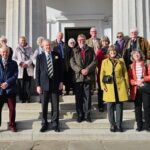
15 November 2023: A group of 28 BACSA members visited the Royal Military Academy at Sandhurst, exploring in detail the beautifully refurbished Indian Army Memorial Room in the historic Old College building, together with the Royal Memorial Chapel and the Roman Catholic Chapel.
We assembled on the steps outside the Palladian portico of Old College, constructed in 1812 by William Wyatt on a site sold to the government by William Pitt the Younger. Originally founded to train infantry and cavalry officers, Sandhurst now trains all officers – male and female – in the regular and reserve forces of the British army, as well as around 90 cadets from 50 other countries.
Outside, tiered seating was being assembled for guests at the forthcoming Sovereign’s Parade. On being commissioned officers are inspected by the Sovereign (or their representative), before marching up the steps and into the double-height entrance hall, famously followed by the Adjutant, still mounted on his charger. The Commandant’s Parades (dress rehearsals for the Sovereign’s Parades) are open to the public – for more information, and to make a booking, please visit the website (‘sandhursttrust.org’), or email ‘tours@sandhursttrust.org’.
After a brief introduction our Sandhurst Trust guides David Wilson and Stuart Hepton split us into two groups to view the Prestige Rooms, including the Marlborough Room (where a leather triptych by Horsenburg depicts the Battle of Blenheim), and the Wellington Room (with two paintings of the Battle of Waterloo by Sir William Allan).
For most BACSA members, though, the highlight of the day was the Indian Army Memorial Room. No longer capacious enough to serve as the College Chapel, this room was used as a dining room and a library before becoming ‘A fitting memorial to over 200 years of service and sacrifice’. With four stained glass windows, it now houses collections of medals, regimental badges and coats of arms, regimental silver, and a display of portraits and paintings.

The first of the four stained glass windows was erected in 1965, to celebrate the 150 years of service of 2nd King Edward VII’s Own Goorkhas, The Sirmoor Rifles, since their founding in 1815. It commemorates the ‘many members of the Regiment who sacrificed their Lives and whose bodies lie on the battlefields of the World’. The second commemorates losses during WWI (in France, Flanders, Mesopotamia, Gallipoli, Egypt, Aden, Persia, NW Frontier, East Africa, Palestine and ‘Trans-Caspia’). The third commemorates those who died fighting with the Indian Army between 1918-1927 (in Waziristan, Afghanistan, Kurdistan and Shanghai), and the fourth commemorates losses in WWII (in North Africa, Eritrea, Burma, Italy, Syria, Malaya, Hong Kong and Greece).
Our guides drew our attention to several of the portraits hanging in the room, including that of Lieutenant-General Colin Mackenzie (1806-1881), a distant relative of one of the members of our group. An Assistant Political Agent at the time of the First Afghan War, Mackenzie was taken prisoner at the same time as George Lawrence, adopted Afghani costume and, known as ‘the English Mullah,’ helped facilitate the safe evacuation of women and children.

Our tour of the Academy was rounded off with visits to the Royal Memorial Chapel (where the names of 3,274 Sandhurst graduates who died in WW1 are inscribed on pillars), and the Roman Catholic Chapel.
Over our sandwich lunch various members of our group raised their own family history-related queries. Our guides, who helpfully relayed them to the curators of the Sandhurst Collection, have kindly offered to assist any other BACSA members in the same way – contact them via their website ‘sandhursttrust.org’. (At present there is no formal charge for research, but donations are welcome).
Our thanks are due to Rosemary Raza, BACSA, for organising our visit; and Louise Martin, Events Co-ordinator at the Sandhurst Trust, who, with her colleagues Tasha Tippett, David Wilson and Stuart Hepton, made it such an interesting day.
